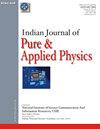In In-silico Identification of Potential Inhibitors of Human Dihydrouridine Synthase 2 for Cancer Therapy
IF 1.1
4区 物理与天体物理
Q4 PHYSICS, MULTIDISCIPLINARY
引用次数: 0
Abstract
The formation of dihydrouridine from uridine substrate is catalysed by the human tRNA-dihydrouridine synthase (hDus2) enzyme. The abundance of dihydrouridine, possibly accumulated due to the aberrant function of hDus2, is linked with carcinogenesis. In this study, we focused on hDus2 enzyme, in hopes of discovering novel molecule with affinity for its tRNA binding site. Using the computational method, we performed virtual screening of a natural compound library (NPACT) with Autodock Vina, followed by validation using Smina and Idock. The top hits ZINC08219592, ZINC44387960, and ZINC95098958 were further investigated for their ADME properties to assess their potential as drug candidates. Additionally, the electronic structure properties of the lead molecules were investigated using Density Functional Theory (DFT). Our findings suggest that the identified natural molecules may act as potential hDus2 binders, opening new possibilities for the development of targeted anticancer drugs. This study provides a foundation for further research and the potential advancement of cancer therapeutics targeting on hDus2.用于癌症治疗的人二氢吡啶合酶2潜在抑制剂的计算机鉴定
尿嘧啶底物由人trna -二氢尿嘧啶合成酶(hDus2)催化生成二氢尿嘧啶。二氢吡啶的丰富,可能是由于hDus2功能异常而积累的,与致癌有关。在本研究中,我们将重点放在hDus2酶上,希望发现与其tRNA结合位点有亲和力的新分子。使用计算方法,我们使用Autodock Vina对天然化合物文库(NPACT)进行虚拟筛选,然后使用Smina和Idock进行验证。ZINC08219592、ZINC44387960和ZINC95098958的ADME特性被进一步研究,以评估它们作为候选药物的潜力。此外,利用密度泛函理论(DFT)研究了铅分子的电子结构性质。我们的研究结果表明,鉴定出的天然分子可能作为潜在的hDus2结合物,为开发靶向抗癌药物开辟了新的可能性。本研究为进一步研究hDus2靶向肿瘤治疗奠定了基础。
本文章由计算机程序翻译,如有差异,请以英文原文为准。
求助全文
约1分钟内获得全文
求助全文
来源期刊
CiteScore
1.30
自引率
14.30%
发文量
42
审稿时长
7 months
期刊介绍:
Started in 1963, this journal publishes Original Research Contribution as full papers, notes and reviews on classical and quantum physics, relativity and gravitation; statistical physics and thermodynamics; specific instrumentation and techniques of general use in physics, elementary particles and fields, nuclear physics, atomic and molecular physics, fundamental area of phenomenology, optics, acoustics and fluid dynamics, plasmas and electric discharges, condensed matter-structural, mechanical and thermal properties, electronic, structure, electrical, magnetic and optical properties, cross-disciplinary physics and related areas of science and technology, geophysics, astrophysics and astronomy. It also includes latest findings in the subject under News Scan.

 求助内容:
求助内容: 应助结果提醒方式:
应助结果提醒方式:


